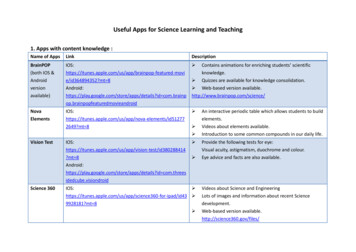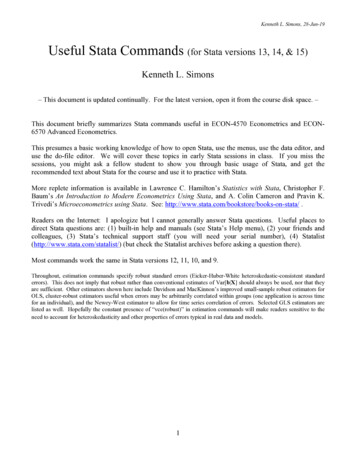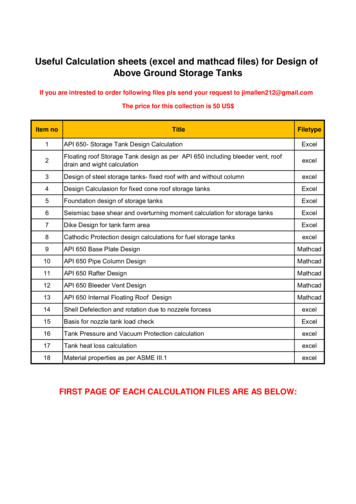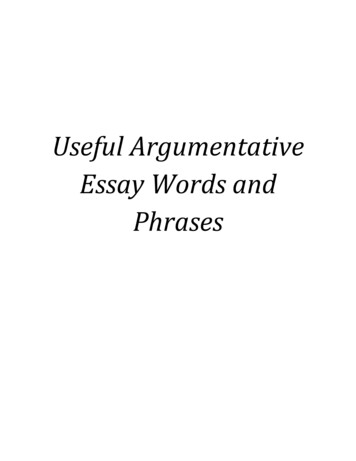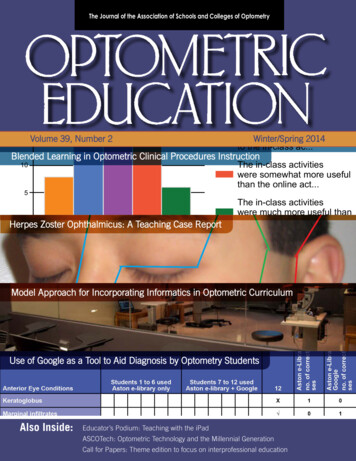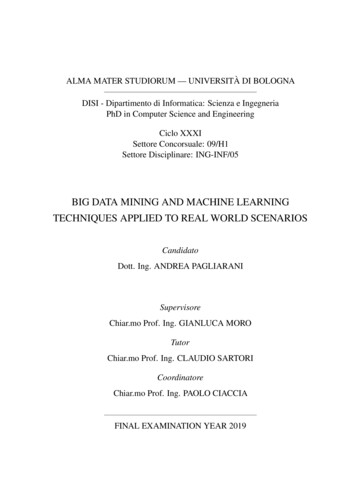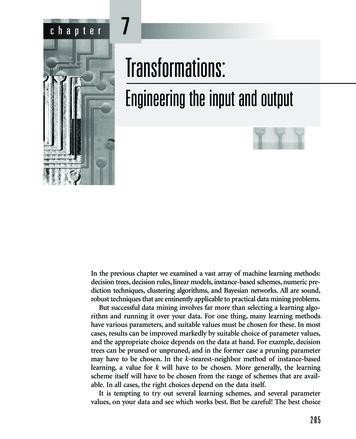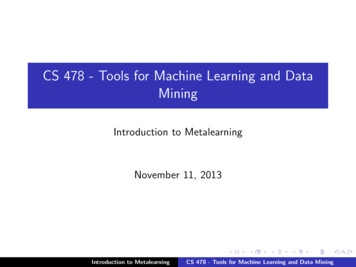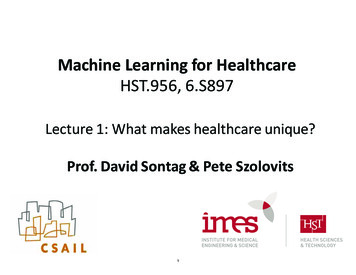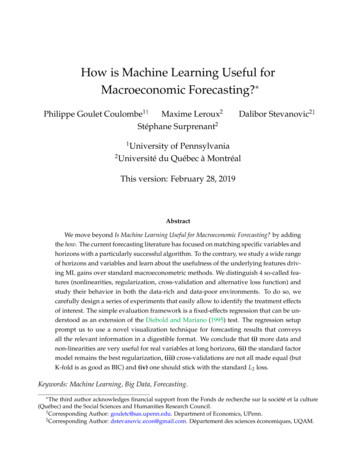
Transcription
How is Machine Learning Useful forMacroeconomic Forecasting? Philippe Goulet Coulombe1†Maxime Leroux2Stéphane Surprenant2Dalibor Stevanovic2‡1University of Pennsylvania2Université du Québec à MontréalThis version: February 28, 2019AbstractWe move beyond Is Machine Learning Useful for Macroeconomic Forecasting? by addingthe how. The current forecasting literature has focused on matching specific variables andhorizons with a particularly successful algorithm. To the contrary, we study a wide rangeof horizons and variables and learn about the usefulness of the underlying features driving ML gains over standard macroeconometric methods. We distinguish 4 so-called features (nonlinearities, regularization, cross-validation and alternative loss function) andstudy their behavior in both the data-rich and data-poor environments. To do so, wecarefully design a series of experiments that easily allow to identify the treatment effectsof interest. The simple evaluation framework is a fixed-effects regression that can be understood as an extension of the Diebold and Mariano (1995) test. The regression setupprompt us to use a novel visualization technique for forecasting results that conveysall the relevant information in a digestible format. We conclude that (i) more data andnon-linearities are very useful for real variables at long horizons, (ii) the standard factormodel remains the best regularization, (iii) cross-validations are not all made equal (butK-fold is as good as BIC) and (iv) one should stick with the standard L2 loss.Keywords: Machine Learning, Big Data, Forecasting. Thethird author acknowledges financial support from the Fonds de recherche sur la société et la culture(Québec) and the Social Sciences and Humanities Research Council.† Corresponding Author: gouletc@sas.upenn.edu. Department of Economics, UPenn.‡ Corresponding Author: dstevanovic.econ@gmail.com. Département des sciences économiques, UQAM.
1IntroductionThe intersection of Machine Learning (ML) with econometrics has become an importantresearch landscape in economics. ML has gained prominence due to the availability of largedata sets, especially in microeconomic applications, Athey (2018). However, as pointed byMullainathan and Spiess (2017), applying ML to economics requires finding relevant tasks.Despite the growing interest in ML, little progress has been made in understanding theproperties of ML models and procedures when they are applied to predict macroeconomicoutcomes.1 Nevertheless, that very understanding is an interesting econometric researchendeavor per se. It is more appealing to applied econometricians to upgrade a standardframework with a subset of specific insights rather than to drop everything altogether foran off-the-shelf ML model.A growing number studies have applied recent machine learning models in macroeconomic forecasting.2 However, those studies share many shortcomings. Some focus on oneparticular ML model and on a limited subset of forecasting horizons. Other evaluate the performance for only one or two dependent variables and for a limited time span. The paperson comparison of ML methods are not very extensive and do only a forecasting horse racewithout providing insights on why some models perform better.3 As a result, little progresshas been made to understand the properties of ML methods when applied to macroeconomic forecasting. That is, so to say, the black box remains closed. The objective of thispaper is to bring an understanding of each method properties that goes beyond the coronation of a single winner for a specific forecasting target. We believe this will be much moreuseful for subsequent model building in macroeconometrics.Precisely, we aim to answer the following question. What are the key features of MLmodeling that improve the macroeconomic prediction? In particular, no clear attempt hasbeen made at understanding why one algorithm might work and another one not. We address this question by designing an experiment to identify important characteristics of machine learning and big data techniques. The exercise consists of an extensive pseudo-outof-sample forecasting horse race between many models that differ with respect to the four1 Onlythe unsupervised statistical learning techniques such as principal component and factor analysishave been extensively used and examined since the pioneer work of Stock and Watson (2002a). Kotchoni et al.(2017) do a substantial comparison of more than 30 various forecasting models, including those based on factoranalysis, regularized regressions and model averaging. Giannone et al. (2017) study the relevance of sparsemodelling (Lasso regression) in various economic prediction problems.2 Nakamura (2005) is an early attempt to apply neural networks to improve on prediction of inflation, whileSmalter and Cook (2017) use deep learning to forecast the unemployment. Diebold and Shin (2018) propose aLasso-based forecasts combination technique. Sermpinis et al. (2014) use support vector regressions to forecastinflation and unemployment. Döpke et al. (2015) and Ng (2014) aim to predict recessions with random forestsand boosting techniques. Few papers contribute by comparing some of the ML techniques in forecasting horseraces, see Ahmed et al. (2010), Ulke et al. (2016) and Chen et al. (2019).3 An exception is Smeekes and Wijler (2018) who compare performance of sparse and dense models inpresence of non-stationary data.2
main features: nonlinearity, regularization, hyperparameter selection and loss function. Tocontrol for big data aspect, we consider data-poor and data-rich models, and administerthose patients one particular ML treatment or combinations of them. Monthly forecast errorsare constructed for five important macroeconomic variables, five forecasting horizons andfor almost 40 years. Then, we provide a straightforward framework to back out which ofthem are actual game-changers for macroeconomic forecasting.The main results can be summarized as follows. First, non-linearities either improvedrastically or decrease substantially the forecasting accuracy. The benefits are significantfor industrial production, unemployment rate and term spread, and increase with horizons,especially if combined with factor models. Nonlinearity is harmful in case of inflation andhousing starts. Second, in big data framework, alternative regularization methods (Lasso,Ridge, Elastic-net) do not improve over the factor model, suggesting that the factor representation of the macroeconomy is quite accurate as a mean of dimensionality reduction.Third, the hyperparameter selection by K-fold cross-validation does better on averagethat any other criterion, strictly followed by the standard BIC. This suggests that ignoring information criteria when opting for more complicated ML models is not harmful. This is alsoquite convenient: K-fold is the built-in CV option in most standard ML packages. Fourth,replacing the standard in-sample quadratic loss function by the ē-insensitive loss functionin Support Vector Regressions is not useful, except in very rare cases. Fifth, the marginaleffects of big data are positive and significant for real activity series and term spread, andimprove with horizons.The state of economy is another important ingredient as it interacts with few featuresabove. Improvements over standard autoregressions are usually magnified if the targetfalls into an NBER recession period, and the access to data-rich predictor set is particularlyhelpful, even for inflation. Moreover, the pseudo-out-of-sample cross-validation failure ismainly attributable to its underperformance during recessions.These results give a clear recommendation for practitioners. For most variables and horizons, start by reducing the dimensionality with principal components and then augment thestandard diffusion indices model by a ML non-linear function approximator of choice. Ofcourse, that recommendation is conditional on being able to keep overfitting in check. Tothat end, if cross-validation must be applied to hyperparameter selection, the best practiceis the standard K-fold.In the remainder of this papers we first present the general prediction problem with machine learning and big data in Section 2. The Section 3 describes the four important featuresof machine learning methods. The Section 4 presents the empirical setup, the Section 5 discuss the main results and Section 6 concludes. Appendices A, B, C, D and E contain, respectively: tables with overall performance; robustness of treatment analysis; additional figures;description of cross-validation techniques and technical details on forecasting models.3
2Making predictions with machine learning and big dataTo fix ideas, consider the following general prediction setup from Hastie et al. (2017)min{ L̂(yt h , g( Zt )) pen( g; τ )},g Gt 1, . . . , T(1)where yt h is the variable to be predicted h periods ahead (target) and Zt is the NZ -dimensionalvector of predictors made of Ht , the set of all the inputs available at time t. Note that thetime subscripts are not necessary so this formulation can represent any prediction problem.This setup has four main features:1. G is the space of possible functions g that combine the data to form the prediction. Inparticular, the interest is how much non-linearities can we allow for? A function g canbe parametric or nonparametric.2. pen() is the penalty on the function g. This is quite general and can accommodate,among others, the Ridge penalty of the standard by-block lag length selection by information criteria.3. τ is the set of hyperparameters of the penalty above. This could be λ in a LASSOregression or the number of lags to be included in an AR model.4. L̂ the loss function that defines the optimal forecast. Some models, like the SVR, featurean in-sample loss function different from the standard l2 norm.Most of (Supervised) machine learning consists of a combination of those ingredients.This formulation may appear too abstract, but the simple predictive regression model canbe obtained as a special case. Suppose a quadratic loss function L̂, implying that the optimalforecast is the conditional expectation E(yt h Zt ). Let the function g be parametric and linear: yt h Zt β error. If the number of coefficients in β is not too big, the penalty is usuallyignored and (1) reduces to the textbook predictive regression inducing E(yt h Zt ) Zt β asthe optimal prediction.2.1Predictive ModelingWe consider the direct predictive modeling in which the target is projected on the information set, and the forecast is made directly using the most recent observables. This is opposedto iterative approach where the model recursion is used to simulate the future path of thevariable.4 Also, the direct approach is the only one that is feasible for all ML models.4 Marcellinoet al. (2006) conclude that the direct approach provides slightly better results but does notdominate uniformly across time and series.4
We now define the forecast objective. Let Yt denote a variable of interest. If ln Yt is astationary, we will consider forecasting its average over the period [t 1, t h] given by:h(h)yt h (1/h) yt k ,(2)k 1where yt lnYt if Yt is strictly positive. Most of the time, we are confronted with I(1) seriesin macroeconomics. For such series, our goal will be to forecast the average annualizedgrowth rate over the period [t 1, t h], as in Stock and Watson (2002b) and McCracken(h)and Ng (2016). We shall therefore define yt h as:(h)yt h (1/h)ln(Yt h /Yt ).(3)(h)In cases where ln Yt is better described by an I(2) process, we define yt h as:(h)yt h (1/h)ln(Yt h /Yt h 1 ) ln(Yt /Yt 1 ).(4)(h)In order to avoid a cumbersome notation, we use yt h instead of yt h in what follows, butthe target is always the average (growth) over the period [t 1, t h].2.2Data-poor versus data-rich environmentsLarge time series panels are now widely constructed and used for macroeconomic analysis.The most popular is FRED-MD monthly panel of US variables constructed by McCrackenand Ng (2016). Fortin-Gagnon et al. (2018) have recently proposed similar data for Canada,while Boh et al. (2017) has constructed a large macro panel for Euro zone. Unfortunately,the performance of standard econometric models tends to deteriorate as the dimensionalityof the data increases, which is the well-known curse of dimensionality. Stock and Watson (2002a) first proposed to solve the problem by replacing the large-dimensional information set by its principal components. See Kotchoni et al. (2017) for the review of manydimension-reduction, regularization and model averaging predictive techniques. Anotherway to approach the dimensionality problem is to use Bayesian methods (Kilian and Lütkepohl (2017)). All the shrinkage schemes presented later in this paper can be seen as a specificprior. Indeed, some of our Ridge regressions will look very much like a direct version of aBayesian VAR with a Litterman (1979) prior.5Traditionally, as all these series may not be relevant for a given forecasting exercise, onewill have to preselect the most important candidate predictors according to economic the5 Giannoneet al. (2015) have shown that a more elaborate hierarchical prior can lead the BVAR to performas well as a factor model5
ories, the relevant empirical literature and own heuristic arguments. Even though the machine learning models do not require big data, they are useful to discard irrelevant predictorsbased on statistical learning, but also to digest a large amount of information to improve theprediction. Therefore, in addition to treatment effects in terms of characteristics of forecasting models, we will also compare the predictive performance of small versus large data sets.The data-poor, defined as Ht , will only contain a finite number of lagged values of the dependent variable, while the data-rich panel, defined as Ht will also include a large numberof exogenous predictors. Formally, we havepyHt {yt j } j 0andhipfpyHt {yt j } j 0 , { Xt j } j 0 .(5)The analysis we propose can thus be summarized in the following way. We will considertwo standard models for forecasting.1. The Ht model is the autoregressive direct (AR) model, which is specified as:yt h c ρ ( L ) yt et h ,t 1, . . . , T,(6)where h 1 is the forecasting horizon. The only hyperparameter in this model is py ,the order of the lag polynomial ρ( L).2. The Ht workhorse model is the autoregression augmented with diffusion indices(ARDI) from Stock and Watson (2002b):yt h c ρ( L)yt β( L) Ft et h ,Xt ΛFt utt 1, . . . , T(7)(8)where Ft are K consecutive static factors, and ρ( L) and β( L) are lag polynomials oforders py and p f respectively. The feasible procedure requires an estimate of Ft that isusually obtained by principal components analysis (PCA).Then, we will take these models as two different types of “patients” and will administerthem one particular ML treatment or combinations of them. That is, we will upgrade (hopefully) these models with one or many features of ML and evaluate the gains/losses in bothenvironments.Beyond the fact that the ARDI is a very popular macro forecasting model, there are additional good reasons to consider it as one benchmark for our investigation. While we discussfour features of ML in this paper, it is obvious that the big two are shrinkage (or dimensionreduction) and non-linearities. Both goes in completely different directions. The first dealswith data sets that have a low observations to regressors ratio while the latter is especiallyuseful when that same ratio is high. Most nonlinearities are created with basis expansions6
which are just artificially generated additional regressors made of the original data. Thatis quite useful in a data-poor environments but is impracticable in data-rich environmentswhere the goal is exactly the opposite, that is, to decrease the effective number of regressors.Hence, the only way to afford non-linear models with wide macro datasets is to compressthe data beforehand and then use the compressed predictors as inputs. Each compressionscheme has an intuitive economic justification of its own. Choosing only a handful of seriescan be justified by some DSGE model that has a reduced-form VAR representation. Compressing the data according to a factor model adheres to the view that are only a few keydrivers of the macroeconomy and those are not observed. We choose the latter option as itsforecasting record is stellar. Hence, our non-linear models implicitly postulate that a sparseset of latent variables impact the target variable in a flexible way. To take PCs of data to feedthem afterward in a NL model is also a standard thing to do from a ML perspective.2.3EvaluationThe objective of this paper is to disentangle important characteristics of the ML predictionalgorithms when forecasting macroeconomic variables. To do so, we design an experimentthat consists of a pseudo-out-of-sample forecasting horse race between many models thatdiffer with respect to the four main features above: nonlinearity, regularization, hyperparameter selection and loss function. To create variation around those treatments, we willgenerate forecasts errors from different models associated to each feature.To test this paper’s hypothesis, suppose the following model for forecasting errorse2t,h,v,m αm ψt,v,h vt,h,v,m(9a)α m α F ηm(9b)where e2t,h,v,m are squared prediction errors of model m for variable v and horizon h at time t.ψt,v,h is a fixed effect term that demean the dependent variable by “forecasting target”, thatis a combination of t, v and h. α F is a vector of αG , α pen() , ατ and α L̂ terms associated to eachfeature. We re-arrange equation (9) to obtaine2t,h,v,m α F ψt,v,h ut,h,v,m .(10)H0 is now α f 0 f F [G , pen(), τ, L̂]. In other words, the null is that there isno predictive accuracy gain with respect to a base model that does not have this particularfeature.6 Very interestingly, by interacting α F with other fixed effects or even variables, we6 Notethat if we are considering two models that differ in one feature and run this regression for a specific(h, v) pair, the t-test on the sole coefficients amounts to a Diebold and Mariano (1995) test – conditional onhaving the proper standard errors.7
can test many hypothesis about the heterogeneity of the “ML treatment effect". Finally, to getinterpretable coefficients, we use a linear combination of e2t,h,v,m by (h, v) pair that makes thefinal regressand (h, v, m) specific average a pseudo-out-of-sample R2 .7 Hence, we defineR2t,h,v,m 1 1Te2t,h,v,mT t 1 (yv,t h ȳv,h )2and runR2t,h,v,m α̇ F ψ̇t,v,h u̇t,h,v,m .(11)On top of providing coefficients α̇ F interpretable as marginal improvements in OOS-R2 ’s,the approach has the advantage of standardizing ex-ante the regressand and thus removingan obvious source of (v, h)-driven heteroscedasticity. Also, a positive α F now means (moreintuitively) an improvement rather than the other way around.While the generality of (10) and (11) is appealing, when investigating the heterogeneityof specific partial effects, it will be much more convenient to run specific regressions for themultiple hypothesis we wish to test. That is, to evaluate a feature f , we run m M f :R2t,h,v,m α̇ f φ̇t,v,h u̇t,h,v,m(12)where M f is defined as the set of models that differs only by the feature under study f .3Four features of MLIn this section we detail the forecasting approaches to create variations for each characteristicof machine learning prediction problem defined in (1).3.1Feature 1: selecting the function gCertainly an important feature of machine learning is the whole available apparatus of nonlinear function estimators. We choose to focus on applying the Kernel trick and RandomForests to our two baseline models to see if the non-linearities they generate will lead tosignificant improvements.3.1.1Kernel Ridge RegressionSince all models considered in this paper can easily be written in the dual form, we canuse the kernel trick (KT) in both data-rich and data-poor environments. It is worth notingthat Kernel Ridge Regression (KRR) has several implementation advantages. First, it has aclosed-form solution that rules out convergence problems associated with models trained7 Precisely: 1T tT 1 1 1Te2t,h,v,mT t 1 (yv,t h ȳv,h )2 R2h,v,m8
with gradient descent. Second, it is fast to implement given that it implies inverting a TxTmatrix at each step (given tuning parameters) and T is never quite large in macro. Sincewe are doing an extensive POOS exercise for a long period of time, these qualities are veryhelpful.We will first review briefly how the KT is implemented in our two benchmark models.Suppose we have a Ridge regression direct forecast with generic regressors ZtTKt 1k 1min (yt h Zt β)2 λ β2k .βThe solution to that problem is β̂ ( Z 0 Z λIk ) 1 Z 0 y. By the representer theorem of Smolaand Schölkopf (2004), β can also be obtained by solving the dual of the convex optimizationproblem above. The dual solution for β is β̂ Z 0 ( ZZ 0 λIT ) 1 y. This equivalence allowsto rewrite the conditional expectation in the following way:tÊ(yt h Zt ) Zt β̂ α̂i hZi , Zt ii 1where α̂ ( ZZ 0 λIT ) 1 y is the solution to the dual Ridge Regression problem. For now,this is just another way of getting exactly the same fitted values.Let’s now introduce a general non-linear model. Suppose we approximate it with basisfunctions φ()yt h g( Zt ) ε t h φ( Zt )0 γ ε t h .The so-called Kernel trick is the fact that there exist a reproducing kernel K () such thattÊ(yt h Zt ) α̂i hφ(Zi ), φ(Zt )i i 1t α̂i K(Zi , Zt ).i 1This means we do not need to specify the numerous basis functions, a well-chosen Kernelimplicitly replicates them. For the record, this paper will be using the standard radial basisfunction kernel k x x 0 k20Kσ (x, x ) exp 2σ2where σ is a tuning parameter to be chosen by cross-validation.Hence, by using the corresponding Zt , we can easily make our data-rich or data-poormodel non-linear. For instance, in the case of the factor model, we can apply it to the regres-9
sion equation to implicitly estimateyt h c g( Zt ) ε t h ,hipfpyZt {yt 0 } j 0 , { Ft j } j 0 ,Xt ΛFt ut .(13)(14)(15)In terms of implementation, this means extracting factor via PCA and then getÊ(yt h Zt ) Kσ ( Zt , Z )(Kσ ( Z, Z ) λIT ) 1 y.(16)The final set of tuning parameters for such a model is τ {λ, σ, py , p f , n f }.3.1.2Random forestsAnother way to introduce non-linearity in the estimation of the predictive equation is to useregression trees instead of OLS. Recall the ARDI model:yt h c ρ( L)yt β( L) Ft ε t h ,Xt ΛFt ut ,where yt and Ft , and their lags, constitute the informational set Zt . This form is clearlylinear but one could tweak the model by replacing it by a regression tree. The idea is to splitsequentially the space of Zt into several regions and model the response by the mean of yt hin each region. The process continues according to some stopping rule. As a result, the treeregression forecast has the following form:fˆ( Z ) M c m I( Z R m ) ,(17)m 1where M is the number of terminal nodes, cm are node means and R1 , ., R M represent apartition of feature space. In the diffusion indices setup, the regression tree would estimatea non-linear relationship linking factors and their lags to yt h . Once the tree structure isknown, this procedure can be related to a linear regression with dummy variables and theirinteractions.Instead of just using one single tree, which is known to be subject to overfitting, we useRandom forests which consist of a certain number of trees using a subsample of observationsbut also a random subset of regressors for each tree.8 The hyperparameter to be cross8 Only using a subsample of observations would be a procedure called Bagging. Also selecting randomlyregressors has the effect of decorrelating the trees and hence improving the out-of-sample forecasting accuracy.10
validated is the number of trees. The forecasts of the estimated regression trees are thenaveraged together to make one single prediction of the targeted variable.3.2Feature 2: selecting the regularizationIn this section we will only consider models where dimension reduction is needed, whichare the models with Ht – that is, more information than just the past values of yt . Thetraditional shrinkage method used in macroeconomic forecasting is the ARDI model thatconsists of extracting principal components of Xt and to use them as data in an ARDL model.Obviously, this is only one out of many ways to compress the information contained inXt to run a well-behaved regression of yt h on it. De Mol et al. (2008) compares Lasso,Ridge and ARDI and finds that forecasts are very much alike. This section can be seenas extending the scope of their study by consider a wider range of models in a updatedforecasting experiment that includes the Great Recession (theirs end in 2003).In order to create identifying variations for pen() treatment, we need to generate multiple different shrinkage schemes. Some will also blend in selection, some will not. Thealternative shrinkage methods consider in this section will all be specific special cases of astandard Elastic Net (EN) problem: TK min (yt h Zt β)2 λ α β k (1 α) β2kβt 1(18)k 1where Zt B( Ht ) is some transformation of the original predictive set Xt . α [0, 1] caneither be fixed or found via cross-validation (CV) while λ 0 always needs to be obtainedby CV. By using different B operators, we can generate shrinkage schemes. Also, by settingα to either 1 or 0 we generate LASSO and Ridge Regression respectively. Choosing α by CValso generate an intermediary regularization scheme of its own. All these possibilities arereasonable alternatives to the traditional factor hard-thresholding procedure that is ARDI.Each type of shrinkage in this section will be defined by the tuple S {α, B()}. To beginwith the most straightforward dimension, for a given B, we will evaluate the results forα {0, α̂CV , 1}. For instance, if B is the identity mapping, we get in turns the LASSO, ElasticNet and Ridge shrinkage.Let us now turn to detail different resulting pen() when we vary B() for a fixed α. Threealternatives will be considered.1. (Fat Regression): First, we will consider the case B1 () I () as mentioned above. Thatis, we use the entirety of the untransformed high-dimensional data set. The results ofGiannone et al. (2017) point in the direction that specifications with a higher α shoulddo better, that is, sparse models do worse than models where every regressor is keptbut shrunk to zero.11
2. (Big ARDI) Second, we will consider the case where B2 () corresponds to first rotatingXt IR N so that we get N uncorrelated Ft . Note here that contrary to the standardARDI model, we do not throw out factors according to some information criteria or ascree test: we keep them all. Hence, Ft has exactly the same span as Xt . If we were torun OLS (without any form of shrinkage), using φ( L) Ft versus ψ( L) Xt would not makeany difference in term of fitted values. However, when shrinkage comes in, a similarpen() applied to a rotated regressor space implicitly generates a new penalty. Comparing LASSO and Ridge in this setup will allow to verify whether sparsity emerges in arotated space. That is, this could be interpreted as looking whether the ’economy’ hasa sparse DGP, but in a different regressor space that the original one. This correspondto the dense view of the economy, which is that observables are only driven by a fewkey fundamental economic shocks.3. (Principal Component Regression) A third possibility is to rotate Ht rather than Xtand still keep all the factors. Ht includes all the relevant pre-selected lags. If wewere to just drop the Ft using some hard-thresholding rule, this would correspond toPrincipal Component Regression (PCR). Note that B3 () B2 () only when no lags areincluded. Here, the Ft have a different interpretation since they are extracted frommultiple t’s data whereas the standard factor model used in econometrics typicallyextract principal components out of Xt in a completely contemporaneous fashion.To wrap up, this means the tuple S has a total of 9 elements. Since we will be consideringboth POOS-CV and K-fold CV for each of these models, this leads to a total of 18 models.Finally, to see clearly through all of this, we can describe where the benchmark ARDImodel stands in this setup. Since it uses a hard thresholding rule that is based on the eigenvalues ordering, it cannot be a special case of the Elastic Net problem. While it is clearlyusing B2 , we would need to set λ 0 and select Ft a priori with a hard-thresholding rule.The closest approximation in this EN setup would be to set α 1 and fix the value of λto match the number of consecutive factors selected by an information criteria directly inthe predictive regression (20) or using an analytically calculated value based on Bai and Ng(2002). However, this would still not impose the ordering of eigenvalues: the Lasso couldhappen to select a Ft associated to a small eigenvalue and yet drop one Ft associated with abigger one.3.3Feature 3: Choosing hyperparameters τThe conventional wisdom in macroeconomic forecasting is to either use AIC or BIC andcompare results. It is well known that BIC selects more parsimonious models than AIC.A relatively new kid on the block is cross-validation, which is widely used in the field of12
machine learning. The prime reason for the popularity of CV is that it can be applied toany model, which includes those for which the derivation of an information criterion isimpossible. An another appeal of the method is its logical simplicity. However, as AIC andBIC, it relies on particular assumpt
The intersection of Machine Learning (ML) with econometrics has become an important research landscape in economics. ML has gained prominence due to the availability of large data sets, especially in microeconomic applications,Athey(2018). However, as pointed by Mullainathan and Spiess(201
